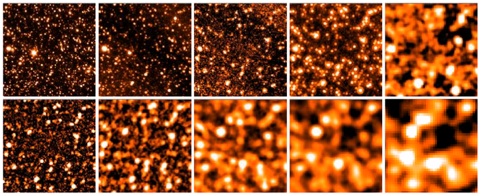As a first release of simulated data, we make here available a new set of Herschel simulated data. They carefully mimics the quality, size and depth of the Herschel images in GOODS-S at 100,160,250,350 and 500um. They are optimally designed to test Herschel source extraction .
These simulations were produced as follows:
- For each MIPS/24um-detected (F24 > 20uJy) source, we derived its far-infrared flux densities at 100,160,250,350 and 500um following the approach presented in Leiton et al. (2014, in prep). The position and flux densities for all the 24um-detected sources are included in the catalog ‘goodsn_24um_prior.save’ (and in ASCII format: list_24um_priors.tbl
- Using the coordinates from the MIPS 24um map (dubbed as RA and DEC in the catalog), each source was injected into the noise map by convolving their flux densities with a PSF model based on the asteroid Vesta and a Gaussian PSF model, for PACS and SPIRE respectively. A random astrometric error around the mean astrometry uncertainty, ~0.425″ in RA and 0.421″ in DEC, was also introduced to the source positions.
Data can be downloaded here

